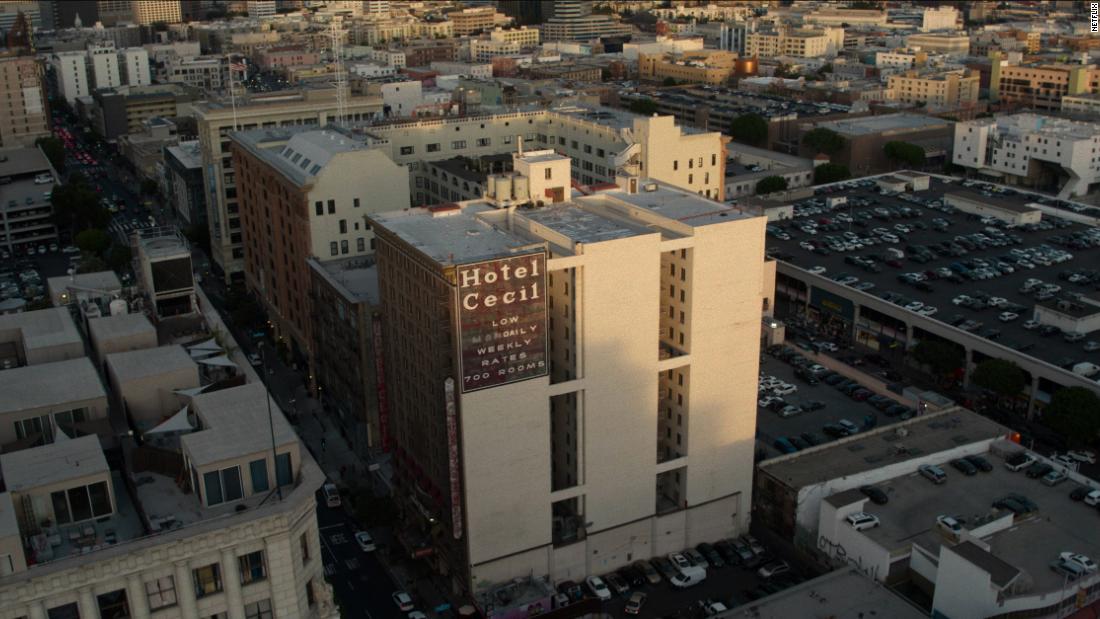After disappearing from her room at the Los Angeles hotel in February 2013, the 21-year-old’s body was found two weeks later, drowned in a water tank on the hotel’s roof.
Almost a decade and dozens of conspiracy theories later, Lam’s case remains unsolved.
Cecil Hotel’s notorious past
The Cecil Hotel’s dark past earned it a place on Los Angeles tours long before a woman’s body was found in her water tank on the roof.
“It’s the place where serial killers are,” Hollywood tour guide Richard Schave told CNN in 2013.
Schave and his wife Kim Cooper took on the job of compiling details about those who killed or were killed while staying at Cecil.
The killers
The most famous on the list are serial killers Richard Ramirez and Jack Unterweger.
In 1985, Ramirez, known as “Nightstalker”, was living on the top floor of Cecil in a $ 14-a-night room, Cooper said.
Cecil, then full of hundreds of passengers who lived in cheap rooms, was a good place for Ramirez to go unnoticed while killing 13 women, Schave said. He was “just throwing his bloody clothes into the trash can at the end of his night and walking in the back door”.
Jack Unterweger worked as a journalist covering Los Angeles crimes for an Austrian magazine in 1991, when he moved to Cecil.
“We believe he was living at Cecil in honor of Ramirez,” said Schave.
He is accused of killing three prostitutes in Los Angeles while he was a guest at Cecil.
The deads
During the 1950s and 1960s, Cecil had a reputation for being a place where people killed themselves by jumping from the windows on the upper floors, Cooper said. “It’s just what people do when they’re at the end of the line,” she said.
Helen Gurnee, in her fifties, jumped out of a seventh-floor window, landing on the Cecil Hotel’s marquee on October 22, 1954, Cooper said.
Julia Moore jumped out of her eighth-floor bedroom window on February 11, 1962, she said. Moore left behind a 59-cent St. Louis bus ticket and an Illinois bank account book showing a balance of $ 1,800.
Pauline Otton, 27, jumped out of a ninth-floor window after an argument with her ex-husband on October 12, 1962, Cooper said. Otton landed on George Gianinni, 65, who was walking on the sidewalk 30 meters below. Both were killed instantly.
Not everyone on Cooper’s list committed suicide.
“Pigeon Goldie” Osgood, a retired telephone operator, was found dead in her looted room on June 4, 1964, Cooper said. Osgood, known for protecting and feeding pigeons in Pershing Square, was stabbed, strangled and raped. The crime has not been solved.
It is not an ordinary hotel
Schave and Cooper have theories as to why Cecil’s past was so sordid.
It was built in the 1920s as a hotel “for business people to come to town and spend a night or two,” said Cooper.
But it was soon supplanted by nicer hotels in a better part of the city, she said. When the Great Depression arrived in the 1930s, it became a more temporary hotel. Eventually, he transitioned to a single room occupation business, known as SRO. Long-time tenants rented single rooms and shared bathrooms with neighboring residents.
“This was just a place for people who were really out of luck,” said Schave. “These hotels are full of people who are on the edge of integrating into society.”
During the 1970s, 1980s and 1990s, hundreds of people who were “out of luck” called Cecil’s home, he said. “They were all struggling to survive.”
“It’s not like that anymore, of course,” said Cooper.
The new owners converted three of the floors back into hotel rooms around 2007, but most of the building remains SRO, Schave said.
